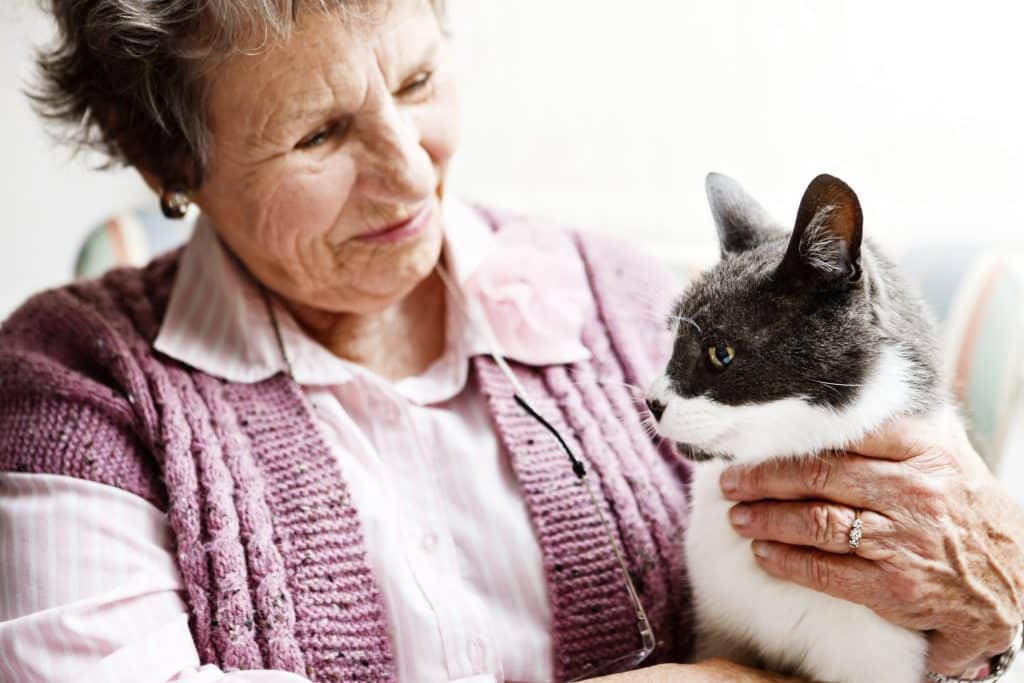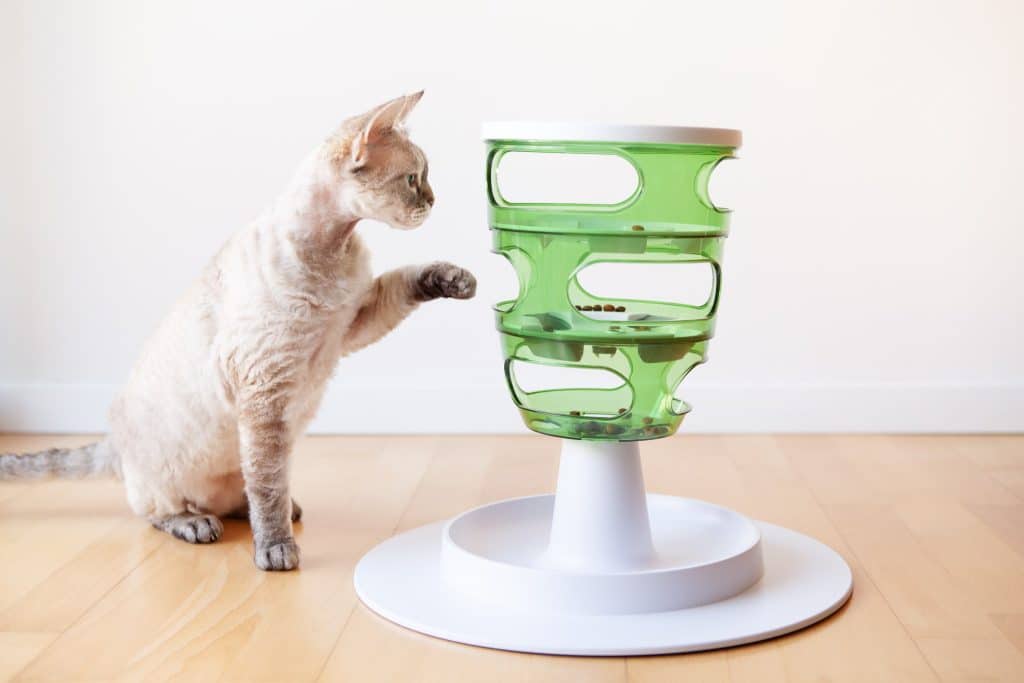Pet parents who’ve had their cats for a long time might wonder when their favourite feline reaches retirement age. Unfortunately, the answer isn’t so clear-cut. Cats can live for 12-15 years on average, but some can reach 18, 19, or even 20 years old, says Patrik Holmboe, DVM, head vet at Cooper Pet Care. That’s equivalent to more than 100 human years! So at what age is a cat considered a senior? It’s a bit arbitrary, but Holmboe says cats are generally ‘senior’ when they are seven or eight.
As your cat ages, it’s natural for them to experience decreased mobility and possible vision changes. However, it’s important to note that being a senior cat doesn’t necessarily mean they’re no longer that spry kitten at heart—or in mind. With a few adjustments at home, you can accommodate their changing needs as your cat enters their golden years.
Read on to learn more about the telltale signs of senior cats and the best care tips for them as they age.
When Do Cats Become Seniors?
Since ‘senior’ denotes a change in a cat’s physical, mental, and nutritional changes rather than a specific age, there is no definitive answer to when your cat is senior. However, Holmboe says most cats are considered seniors around seven or eight years old, regardless of their breed (although some breeds, like Siamese cats, may live longer on average). Interestingly, all cats are living longer in general, and seven-year-old cats aren’t that old nowadays, thanks to veterinary advancements and a better understanding of cats’ nutritional needs.
He adds that indoor cats live longer than outdoor cats since they face fewer risks and hazards.
Cats age differently, so projecting human age onto cats isn’t always accurate. However, to get a rough idea of how old your cat is in human years, Holmboe says to multiply their actual age by seven. Keep in mind that cats mature more quickly in their early years and more slowly as they get older, so this scale could underestimate your adolescent cat’s age and overestimate your senior cat’s age.

iStock/1001slide
How To Tell If Your Cat’s A Senior
Just like humans, Holmboe says ageing varies from cat to cat. “But in most cases, things progress similarly,” he says. Here are some signs that your cat is reaching their senior years. If your cat is experiencing any of these changes or otherwise slowing down in activity, it’s crucial to schedule a visit with your veterinarian rather than assuming the changes are normal ageing.
| Physical Signs of Senior Cats | Behavioural Signs of Senior Cats | Health Changes for Senior Cats |
| Greying muzzle and whiskers | Increase in vocalisation | Loss of senses, including vision, hearing, and taste |
| Hazy eyes and dimmed irises | Less interest in play and activity | Appetite changes |
| Dull, matted or unkempt fur | Sleeping more | Weight loss or loss of muscle mass |
| Brittle nails | Disorientation | Mobility changes |
| Thinner, less elastic skin | Confusion | More prone to infections and illness |
What Health Conditions Are Not A Part Of Normal Cat Ageing?
Ageing itself is not a disease. However, with ageing comes an increased likelihood of illness and disease that your veterinarian may be able to treat or manage.
Holmboe recommends older cats see their veterinarian every six to 12 months for a general wellness exam. To remain vigilant about your cat’s health, weigh your cat between vet visits every two to four weeks. Look for any changes in their behaviour and schedule a vet visit when anything seems out of the norm. Doing this will give you a better chance of catching any medical issues that could otherwise look like ageing.
Generally, vomiting, diarrhoea, increased urination, and weight loss are indications of a medical condition and require a trip to the vet, Holmboe says. Here are some medical conditions you might assume are a part of normal cat ageing, but Holmboe says they aren’t.
Your cat has cognitive dysfunction
Like Alzheimer’s disease in humans, cats can develop dementia as they age. It’s typically diagnosed in cats 10 years or older, but it warrants a vet visit to rule out other possible underlying causes for the symptoms.
Signs of cognitive dysfunction in older cats may include the following:
- getting lost in unfamiliar places
- loss of interest in playing
- sleeping too much, or other changes in sleeping patterns
- staring blankly at walls or into space
- loss of interest in food or water
- toileting outside of the litter box
- loud vocalising, especially at night

iStock/RapidEye
Your cat has osteoarthritis
Arthritis in cats comes in different forms, but the most common one is osteoarthritis, or the inflammation of and damage to the joints over time. Unfortunately, cats are known for hiding discomfort, and small changes in mobility can be hard to spot. This makes it easy to overlook or mistake osteoarthritis for regular age-related changes. However, early diagnosis can slow the disease’s progression and help you appropriately manage pain.
Signs of joint pain from osteoarthritis may include:
- changes in litter box use
- Decrease in activity, including not wanting to get up, use stairs, or jump
- limping
- sensitivity to touch
- weight loss
- depression
- poor grooming habits
Your cat has kidney disease
It’s estimated that anywhere from two to 20% of all cats experience chronic kidney disease during their lifetime, with the likelihood of chronic kidney disease increasing to 30% in senior cats 16 years and older. While there is no cure, kidney disease can be managed through diet and medications.
Signs of kidney disease in senior cats may include:
- increased thirst
- excessive urination
- weight loss despite normal appetite
- lack of energy
- poor grooming habits
Your cat has dental disease
All cats are at risk of dental disease, but dental disease and the discomfort it causes could be overlooked as part of normal cat ageing.
Signs of dental disease may include:
- decreased appetite
- dropping food
- aggression
- bad breath
- drooling
- pawing at the mouth
- weight loss

iStock/Zheka-Boss
How To Care For A Senior Cat
Pet parents with senior cats know they require special care. Luckily, caring for an older cat starts with a few simple changes at home. Then, talk with your vet about how often your cat should be examined and any recommended dietary changes.
Purchase senior cat food
Senior cat food should generally be lower in calories and higher in protein to counteract an old cat’s slower metabolism and muscle loss, Holmboe says. However, not all senior diets meet these criteria, and low-calorie, high-protein diets might not be appropriate for every senior cat. When choosing a senior cat diet, always consult your veterinarian.
Make your home accessible
“Even if no signs are present, the safest option is to assume that a senior cat is decreasing in their mobility—whether it’s due to arthritis or not,” Holmboe explains. Simple ways to make your home more accessible to your senior cat is by offering low-entry litter boxes and ramps or steps to their favourite spots.
Additionally, if your senior cat is experiencing vision loss, keeping your home’s layout unchanged is best to avoid confusion or injuries. Rearranging furniture can cause your cat to bump into objects or miss jumps. Installing nightlights in frequently visited areas, such as around the litter box, food, and water, can also be helpful since your cat’s night vision may be affected.

iStock/insonnia
Schedule routine vet visits
Your vet may want to see your senior cat for a wellness visit every six months rather than once a year. In addition to weight monitoring and listening to your cat’s heart, your vet may recommend a senior blood panel. “There is no question that running a full blood and urine profile every six to 12 months gives you a greater chance of detecting serious medical issues earlier than if relying on symptoms alone,” Holmboe says. “However, this comes with a financial cost, and it’s ultimately up to the [pet parent] to decide.”
If you are the parent to an older cat, you should invest in a pet insurance plan since you’ll be seeing the vet more frequently.
Learn how to groom your cat
Help your cat reach those hard-to-groom spots by brushing them multiple times a week. If you notice any mats forming, your groomer or veterinarian may need to shave that portion of the body. To keep their skin and fur healthy, ask your veterinarian if they recommend diets enriched with omega fatty acids.
Invest in senior-friendly toys
Senior cats still love and require exercise—both mentally and physically. Rather than an exuberant play session with a wand, your senior cat may prefer swatting at a ball tower or solving a food puzzle.
Provide comfortable bedding
Warm, supportive bedding can feel soothing to a cat with arthritis and comfy to just about any cat. Choosing an orthopaedic cat bed ensures your cat gets the optimal level of joint support and pressure relief in just the right spots. Dog beds might even be a better fit for your older cat!
While these tips are a great starting point for many healthy and happy golden years, your veterinarian is the best resource for tailored suggestions on caring for your senior cat.



